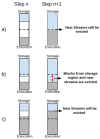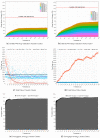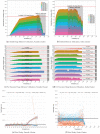Performance Evaluation Analysis of Spark Streaming Backpressure for Data-Intensive Pipelines
- PMID: 35808249
- PMCID: PMC9269592
- DOI: 10.3390/s22134756
Performance Evaluation Analysis of Spark Streaming Backpressure for Data-Intensive Pipelines
Abstract
A significant rise in the adoption of streaming applications has changed the decision-making processes in the last decade. This movement has led to the emergence of several Big Data technologies for in-memory processing, such as the systems Apache Storm, Spark, Heron, Samza, Flink, and others. Spark Streaming, a widespread open-source implementation, processes data-intensive applications that often require large amounts of memory. However, Spark Unified Memory Manager cannot properly manage sudden or intensive data surges and their related in-memory caching needs, resulting in performance and throughput degradation, high latency, a large number of garbage collection operations, out-of-memory issues, and data loss. This work presents a comprehensive performance evaluation of Spark Streaming backpressure to investigate the hypothesis that it could support data-intensive pipelines under specific pressure requirements. The results reveal that backpressure is suitable only for small and medium pipelines for stateless and stateful applications. Furthermore, it points out the Spark Streaming limitations that lead to in-memory-based issues for data-intensive pipelines and stateful applications. In addition, the work indicates potential solutions.
Keywords: backpressure; big data; spark streaming; stream processing.
Conflict of interest statement
The authors declare no conflict of interest.
Figures









References
-
- Hassanien A.E., Darwish A. Machine Learning and Big Data Analytics Paradigms: Analysis, Applications and Challenges. Volume 77 Springer Nature; Berlin/Heidelberg, Germany: 2020.
-
- Tang Z., Zeng A., Zhang X., Yang L., Li K. Dynamic Memory-Aware Scheduling in Spark Computing Environmen. J. Parallel Distrib. Comput. 2020;141:10–22. doi: 10.1016/j.jpdc.2020.03.010. - DOI
-
- da Silva Veith A., Dias de Assuncao M., Lefevre L. Latency-Aware Strategies for Deploying Data Stream Processing Applications on Large Cloud-Edge Infrastructure. IEEE Trans. Cloud Comput. 2021:11236. doi: 10.1109/TCC.2021.3097879. - DOI
-
- Toshniwal A., Taneja S., Shukla A., Ramasamy K., Patel J.M., Kulkarni S., Jackson J., Gade K., Fu M., Donham J., et al. Storm@twitter; Proceedings of the ACM SIGMOD International Conference on Management of Data; Snowbird, UT, USA. 22–27 June 2014; pp. 147–156. - DOI
MeSH terms
LinkOut - more resources
Full Text Sources

